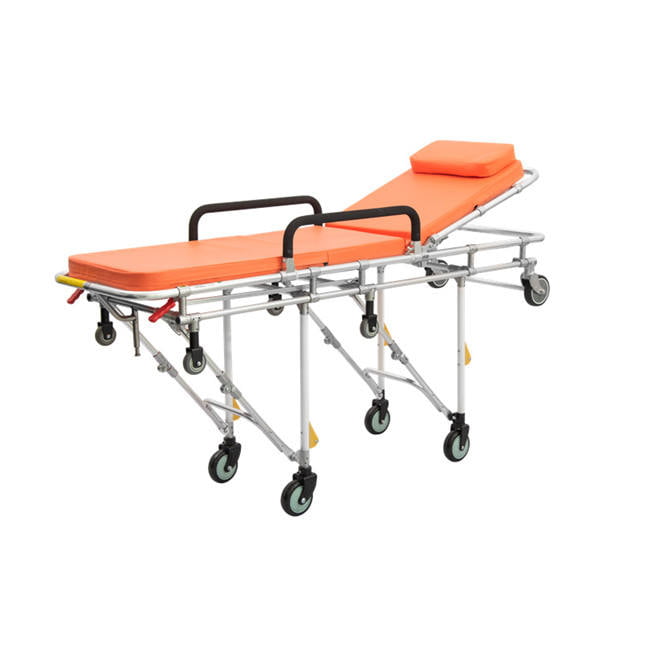Selecting the right medical stretcher is a critical decision for any healthcare facility, emergency medical service provider, or even home care agency. A well-chosen stretcher directly impacts patient safety, comfort, and dignity during transport, while also significantly influencing the efficiency and safety of caregivers. With various types and models available, understanding the key features to look for is essential to ensure you invest in equipment that meets your specific needs and provides reliable performance. This post outlines the most important features to consider when choosing a medical stretcher.
1. Beyond Basic Transport: What Makes a Stretcher Effective?
A modern medical stretcher is more than just a surface on wheels. It’s a piece of medical equipment designed to provide a safe, stable, and adaptable platform for patients during transport and even some initial care. Evaluating its effectiveness goes beyond its ability to simply move a patient from point A to point B.
2. Key Features to Evaluate When Choosing a Medical Stretcher
Here are the most critical features to consider:
2.1. Weight Capacity
Why it’s important: This is fundamental for patient safety. The stretcher’s weight capacity must comfortably accommodate the heaviest patients you anticipate transporting, including bariatric individuals. Using a stretcher below its weight limit is a significant safety hazard.
What to look for: Clearly stated weight limits from the manufacturer. Consider your patient population demographics and choose a stretcher with a capacity that exceeds your anticipated needs.
2.2. Adjustability (Height, Backrest, Leg Rest)
Why it’s important: Adjustable features enhance patient comfort, allow for optimal positioning for specific medical conditions (e.g., elevating the head for respiratory distress, Trendelenburg position for shock), and facilitate safer transfers to and from surfaces of different heights (beds, chairs, imaging tables). Height adjustability is also crucial for caregiver ergonomics.
What to look for: Easy-to-use mechanisms for adjusting height, backrest angle, and leg rest position. Ensure the range of adjustability meets the needs of your patient population and typical transfer scenarios.
2.3. Maneuverability and Wheels
Why it’s important: Smooth and easy maneuverability is vital for navigating tight spaces, corners, and different flooring types, especially in emergency situations. Poorly maneuvering stretchers increase the risk of bumping into obstacles and can cause strain on caregivers.
What to look for: Wheel size and type (larger wheels often handle uneven surfaces better). Swivel capabilities for easy turning. High-quality bearings for smooth rolling. Reliable wheel locks to secure the stretcher when stationary.
2.4. Safety Features (Side Rails, Patient Restraints, Locking Mechanisms)
Why it’s important: Preventing patient falls during transport is paramount. Secure restraints and sturdy side rails are essential to keep the patient safely on the stretcher.
What to look for: Durable and easy-to-operate fold-down side rails. Multiple points for attaching patient restraints. Reliable locking mechanisms for the stretcher frame (e.g., when transferring or performing procedures).
2.5. Material and Construction (Durability, Cleanliness, Weight)
Why it’s important: The materials affect the stretcher’s durability, weight, and ability to be properly cleaned and disinfected – crucial for infection control.
What to look for: Sturdy, high-quality frame material (e.g., aluminum alloy). Surfaces that are non-porous, smooth, and resistant to common cleaning agents. Construction that minimizes crevices where dirt and pathogens can accumulate. Consider the stretcher’s weight, especially for models that require manual lifting into an ambulance.
2.6. Compatibility (Ambulance Fastening Systems, Imaging Equipment)
Why it’s important: For EMS providers, compatibility with the ambulance’s fastening system is non-negotiable for safe transport. For hospital stretchers, compatibility with imaging equipment tables (X-ray, CT, MRI) can streamline workflow.
What to look for: Certification of compatibility with specific ambulance makes/models or imaging equipment.
2.7. Comfort (Mattress, Padding)
Why it’s important: While safety and functionality are primary, patient comfort contributes to a more positive experience and can reduce agitation.
What to look for: A comfortable, supportive, and easy-to-clean mattress or padding. Consider features like pressure-reducing surfaces if patients will spend extended time on the stretcher.
2.8. Ergonomics for Caregivers
Why it’s important: Features that reduce physical strain on caregivers are essential for preventing occupational injuries.
What to look for: Adjustable height, well-placed pushing and pulling handles, smooth-rolling wheels, and intuitive controls that minimize bending or awkward movements for staff.
3. Considering Your Specific Needs
Prioritize these features based on your primary application:
- Ambulance Services: Focus heavily on weight capacity, compatibility with fastening systems, maneuverability over varied terrain, and caregiver ergonomics for loading/unloading.
- Hospital Transport: Prioritize adjustability for transfers between different surfaces, maneuverability in hallways and elevators, and ease of cleaning.
- Specialty Areas (e.g., Bariatrics, Pediatrics): Look for stretchers specifically designed for those patient populations.
4. Conclusion: A Strategic Investment in Safety and Efficiency
Choosing a medical stretcher is a strategic investment that impacts the quality and safety of patient care and the well-being of your staff. By carefully evaluating key features such as weight capacity, adjustability, maneuverability, safety features, and material construction, you can select a medical stretcher that is not only reliable and durable but also optimized for the specific demands of your environment. Making an informed decision ensures safer patient transfers, reduces the risk of caregiver injuries, and contributes to overall operational efficiency.

